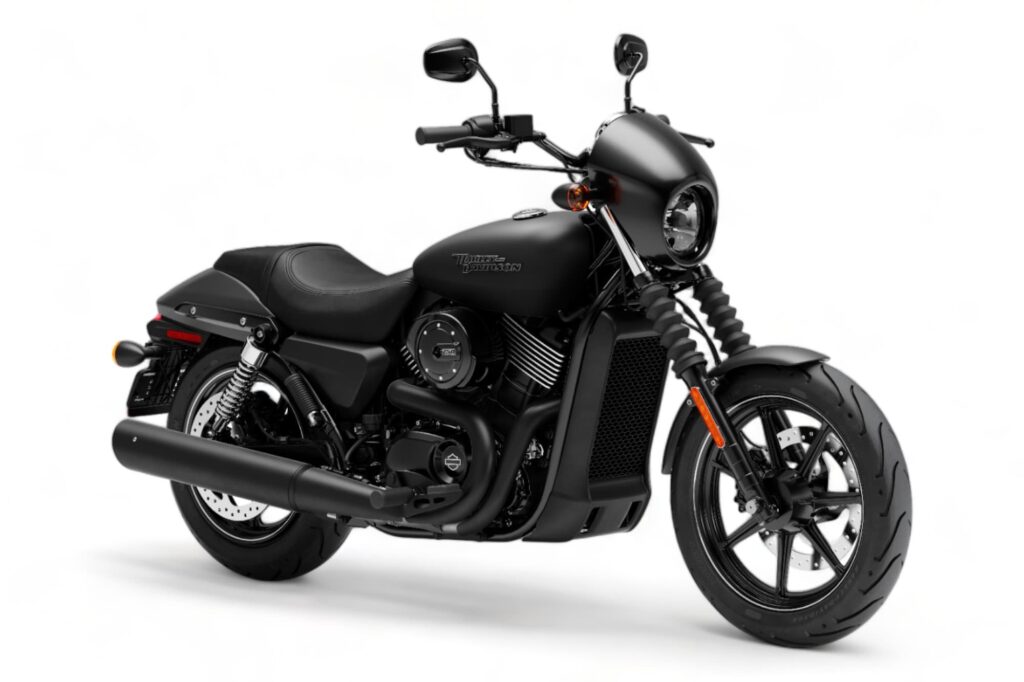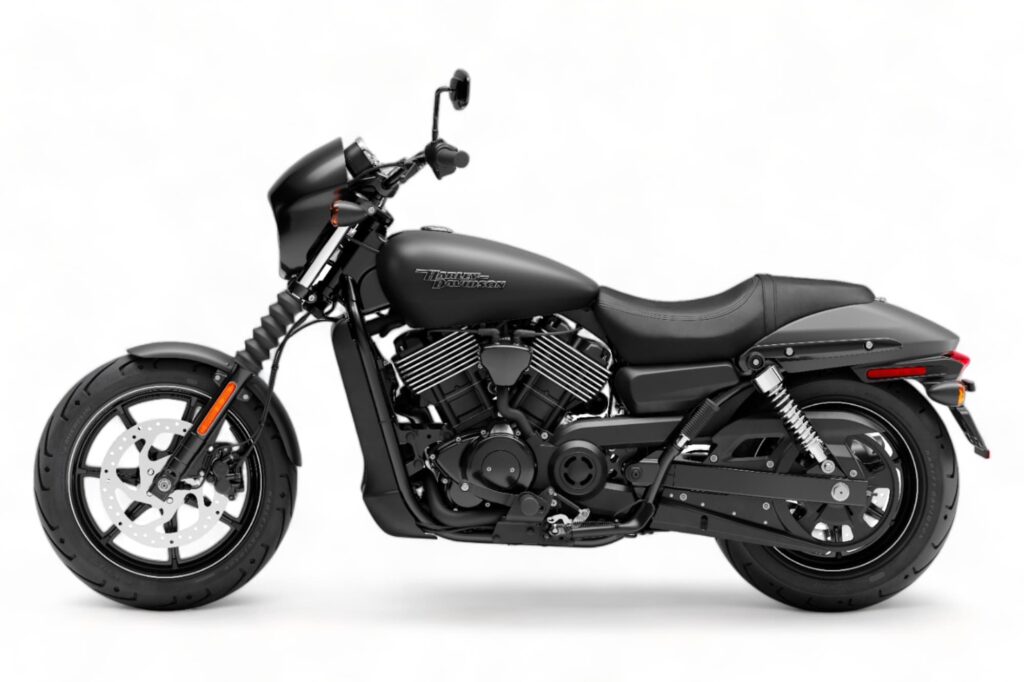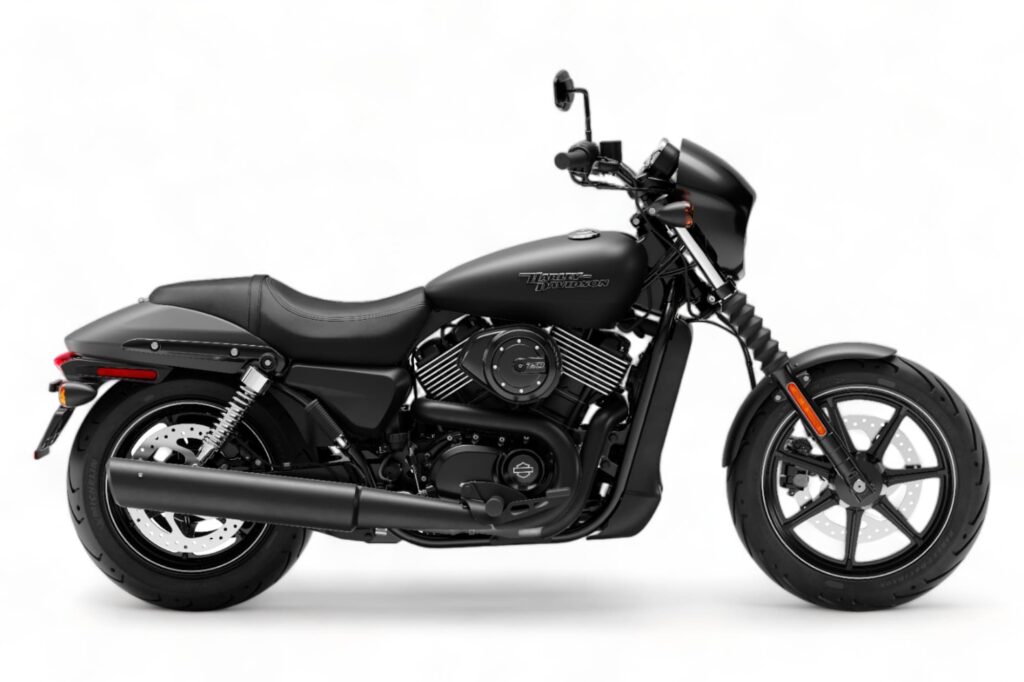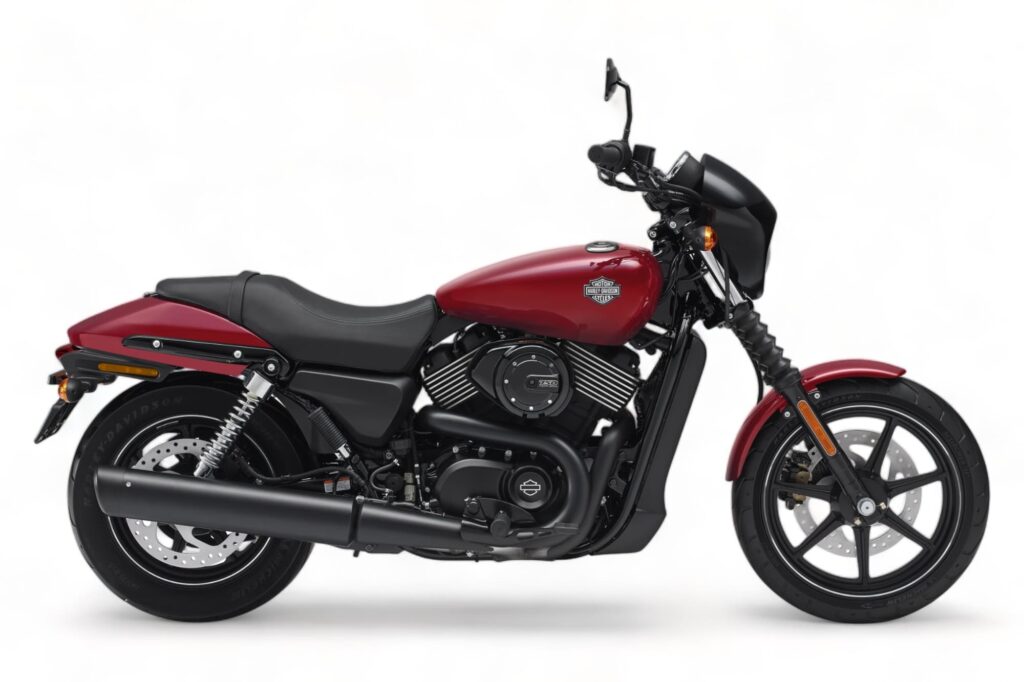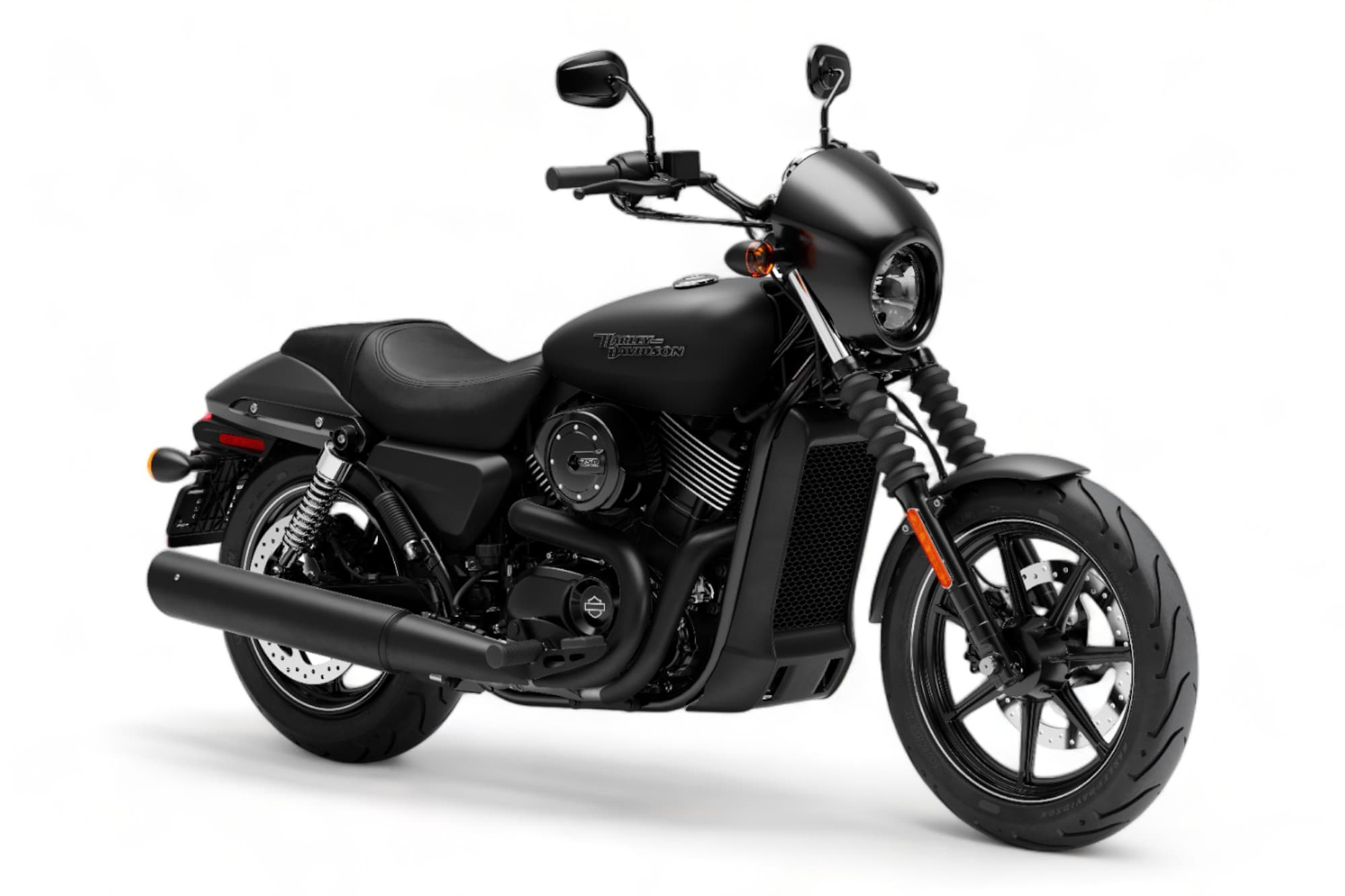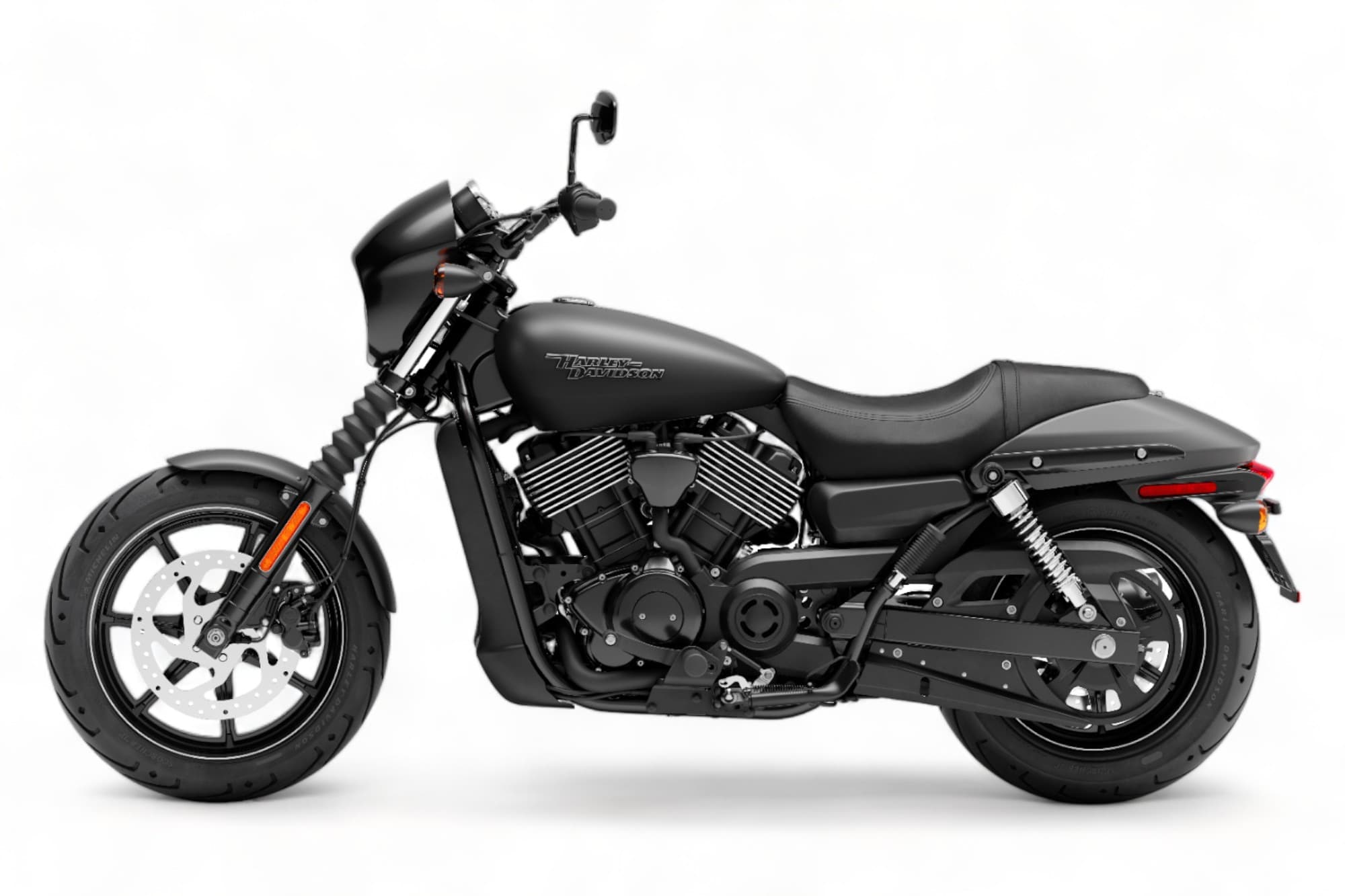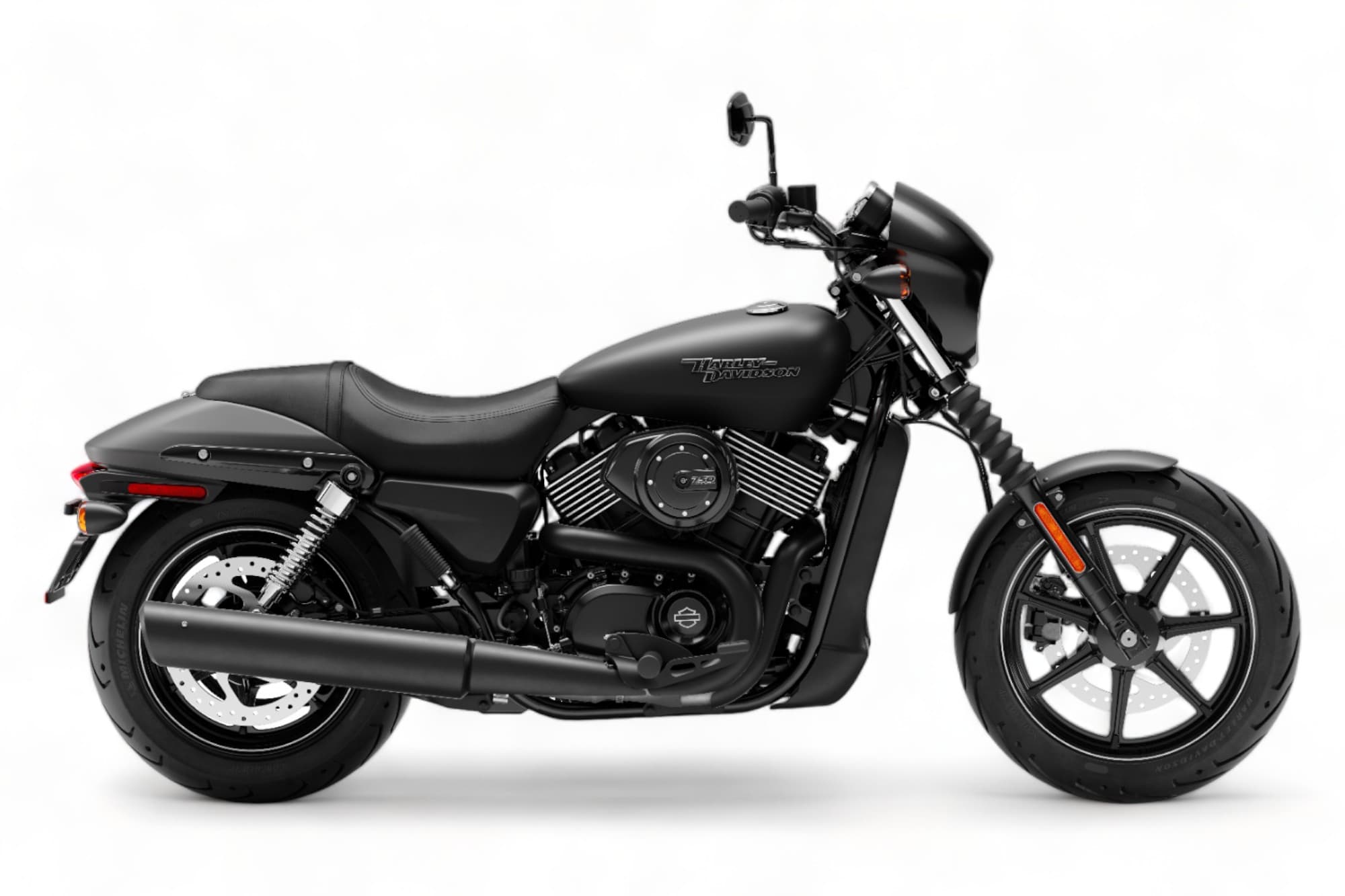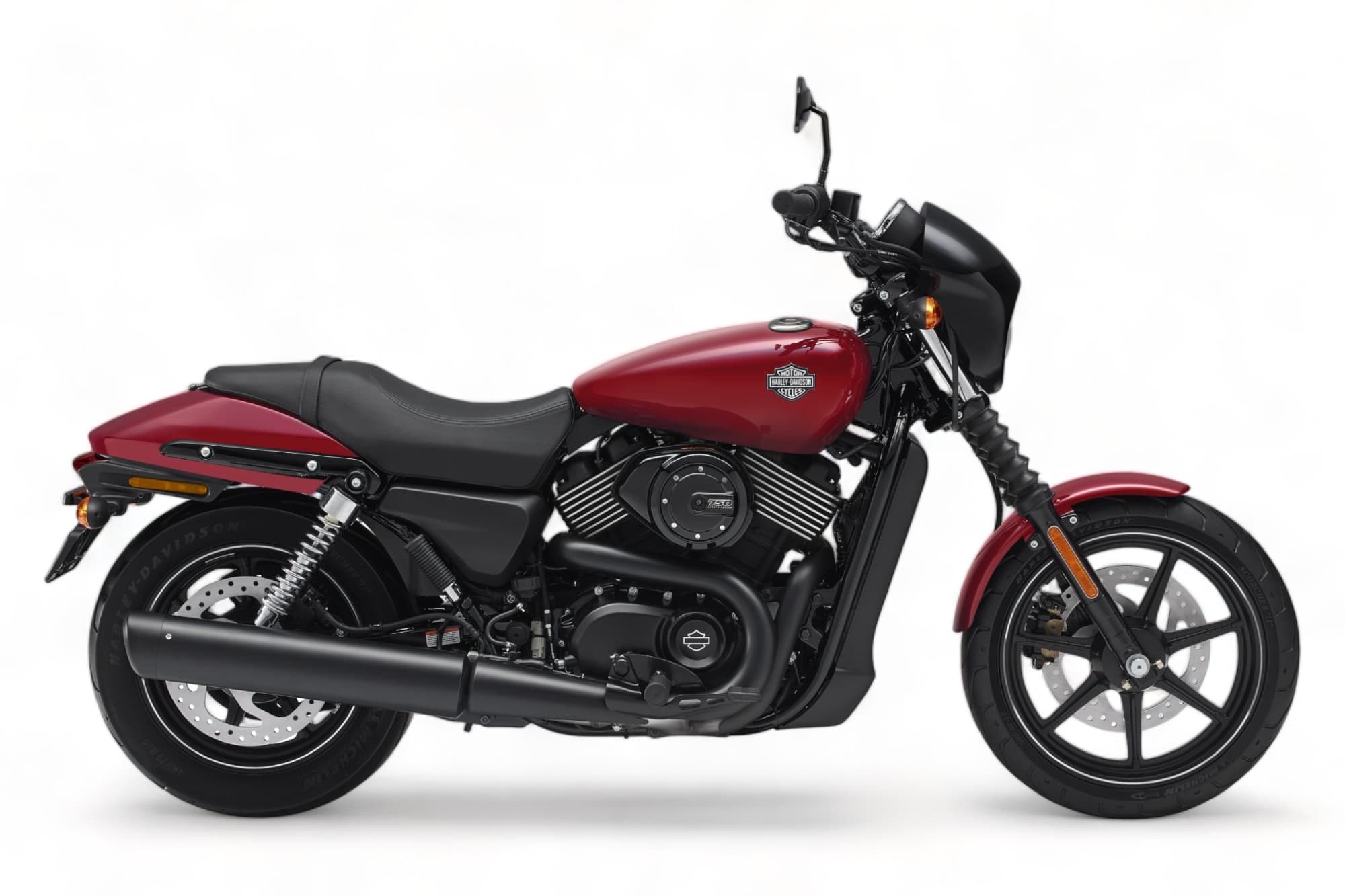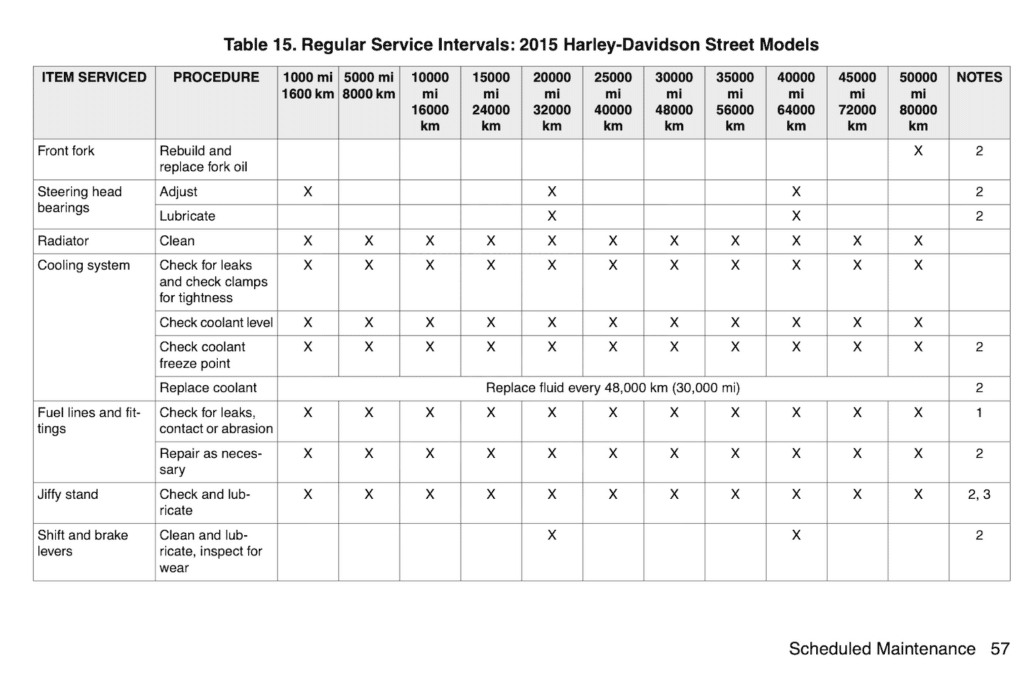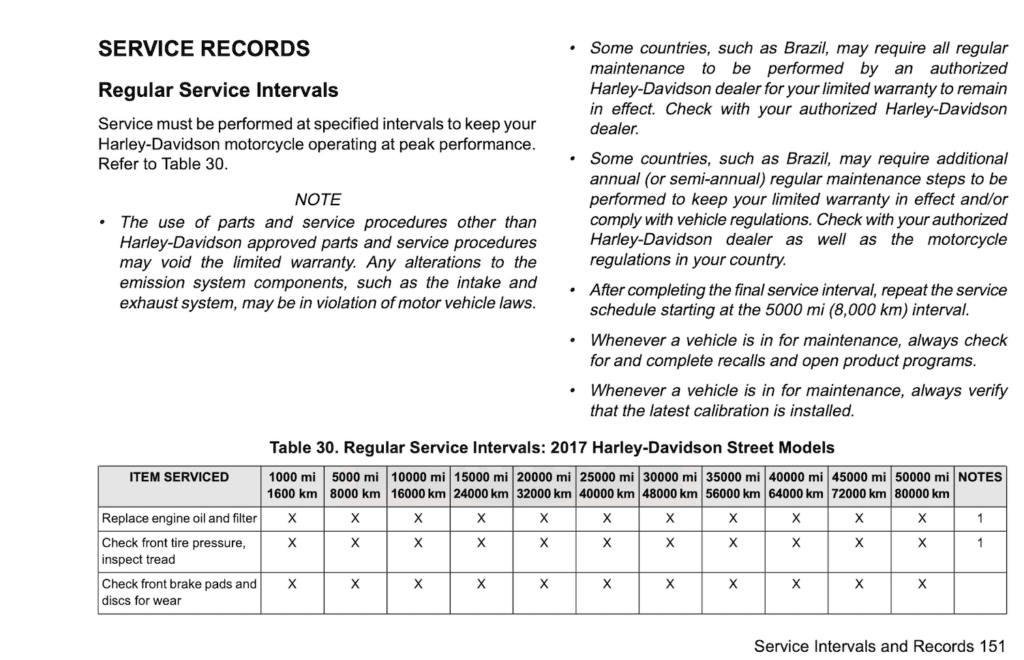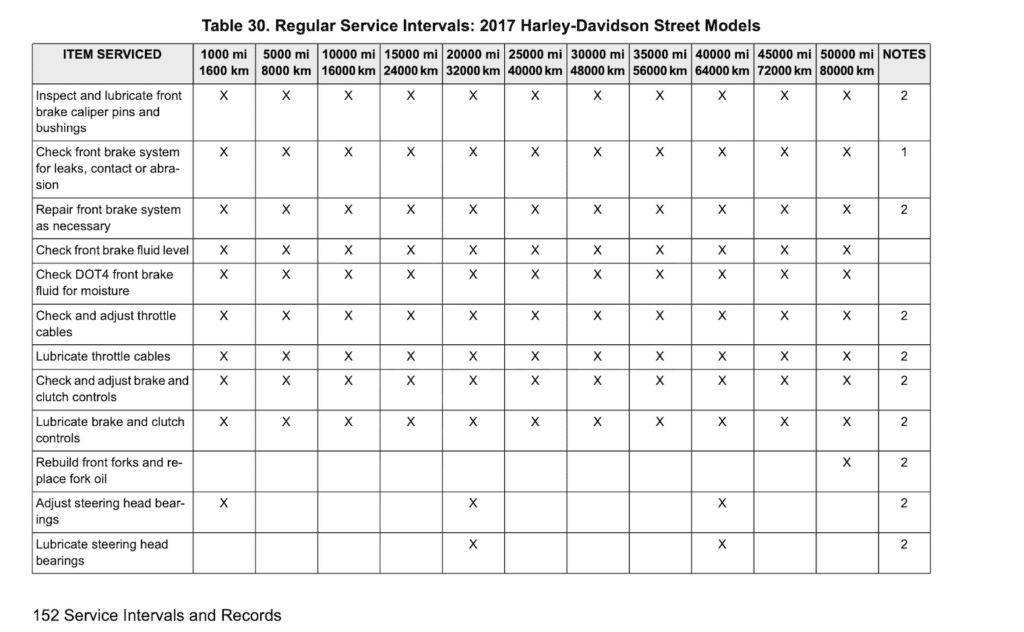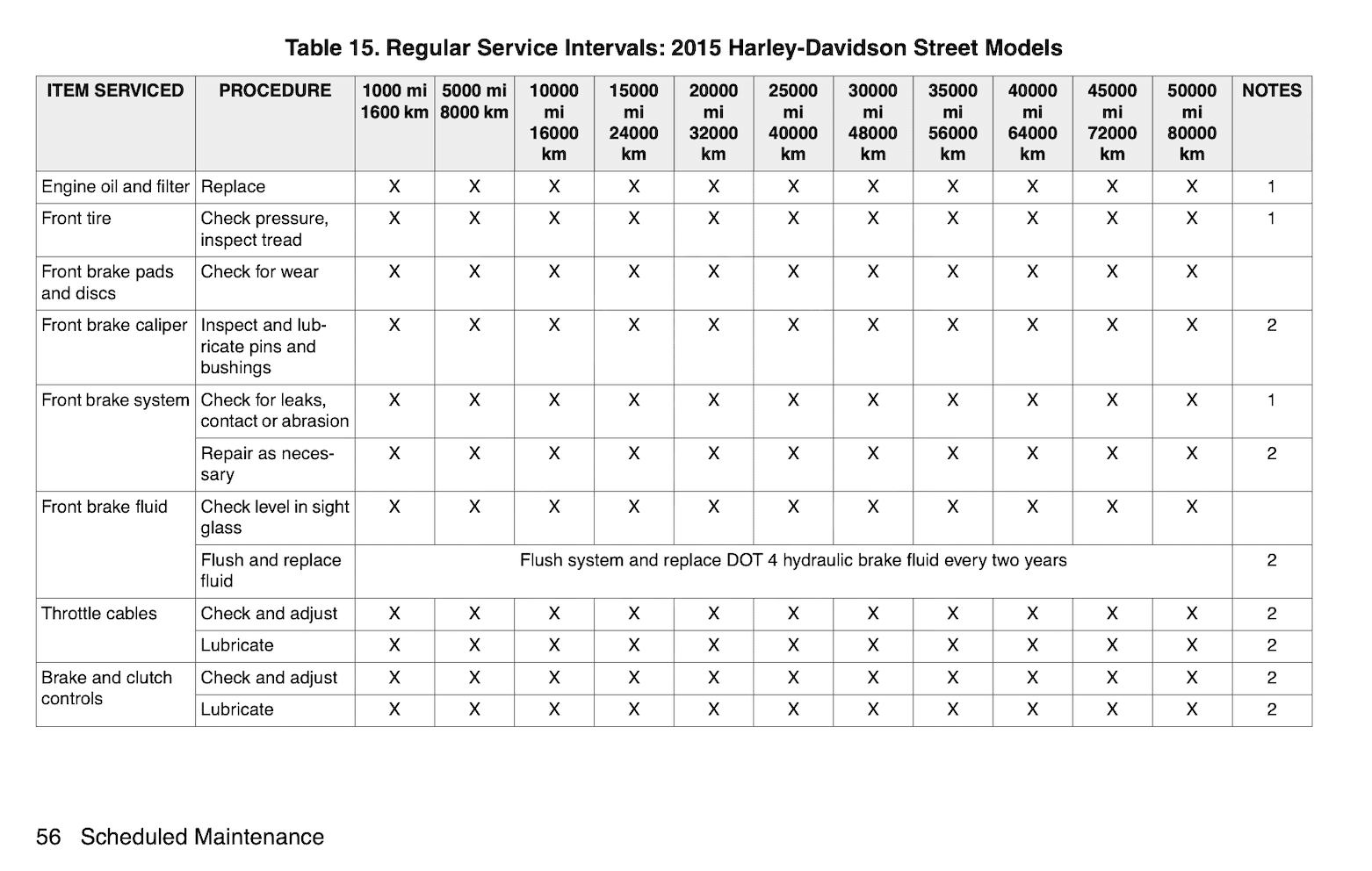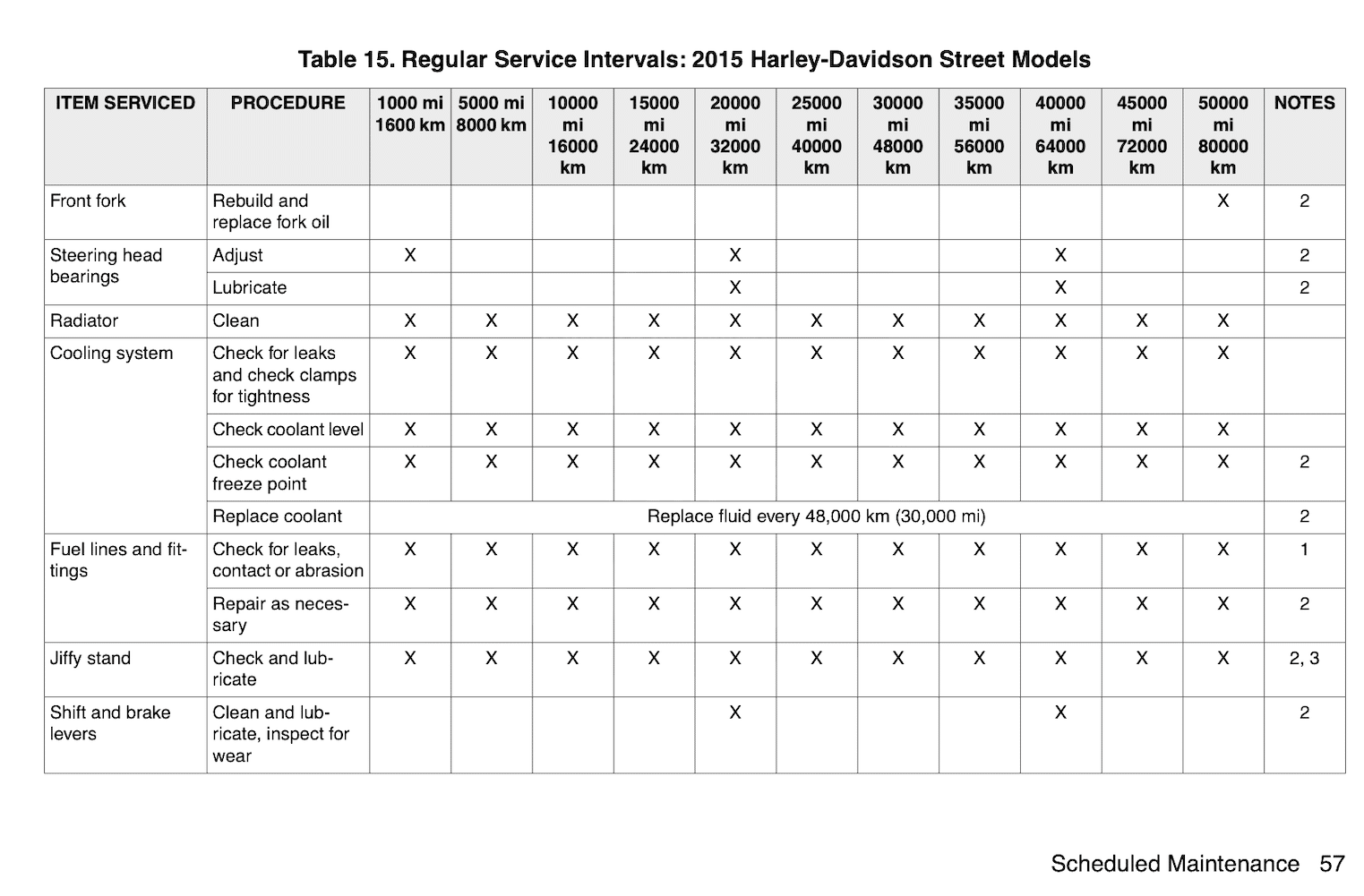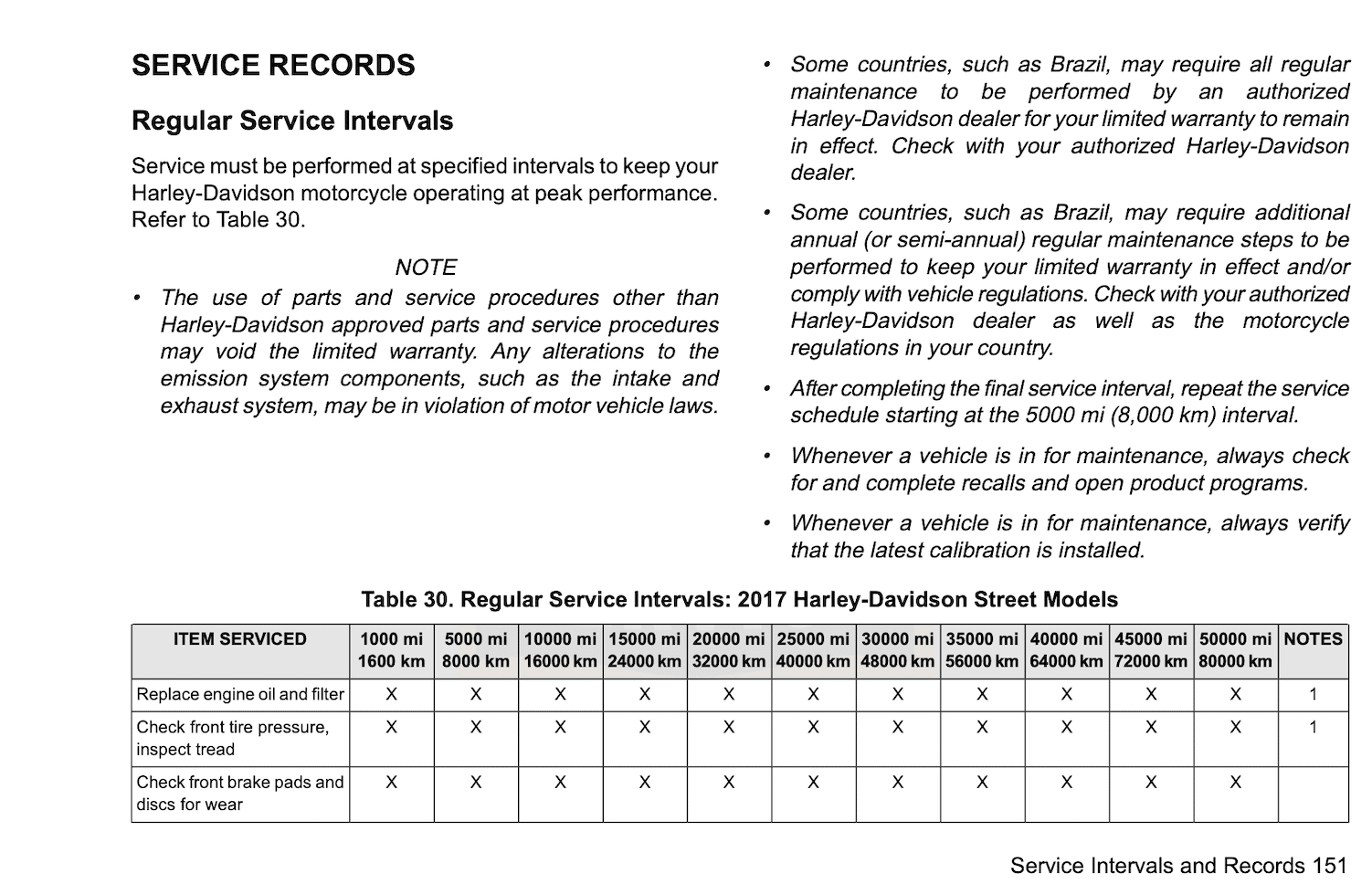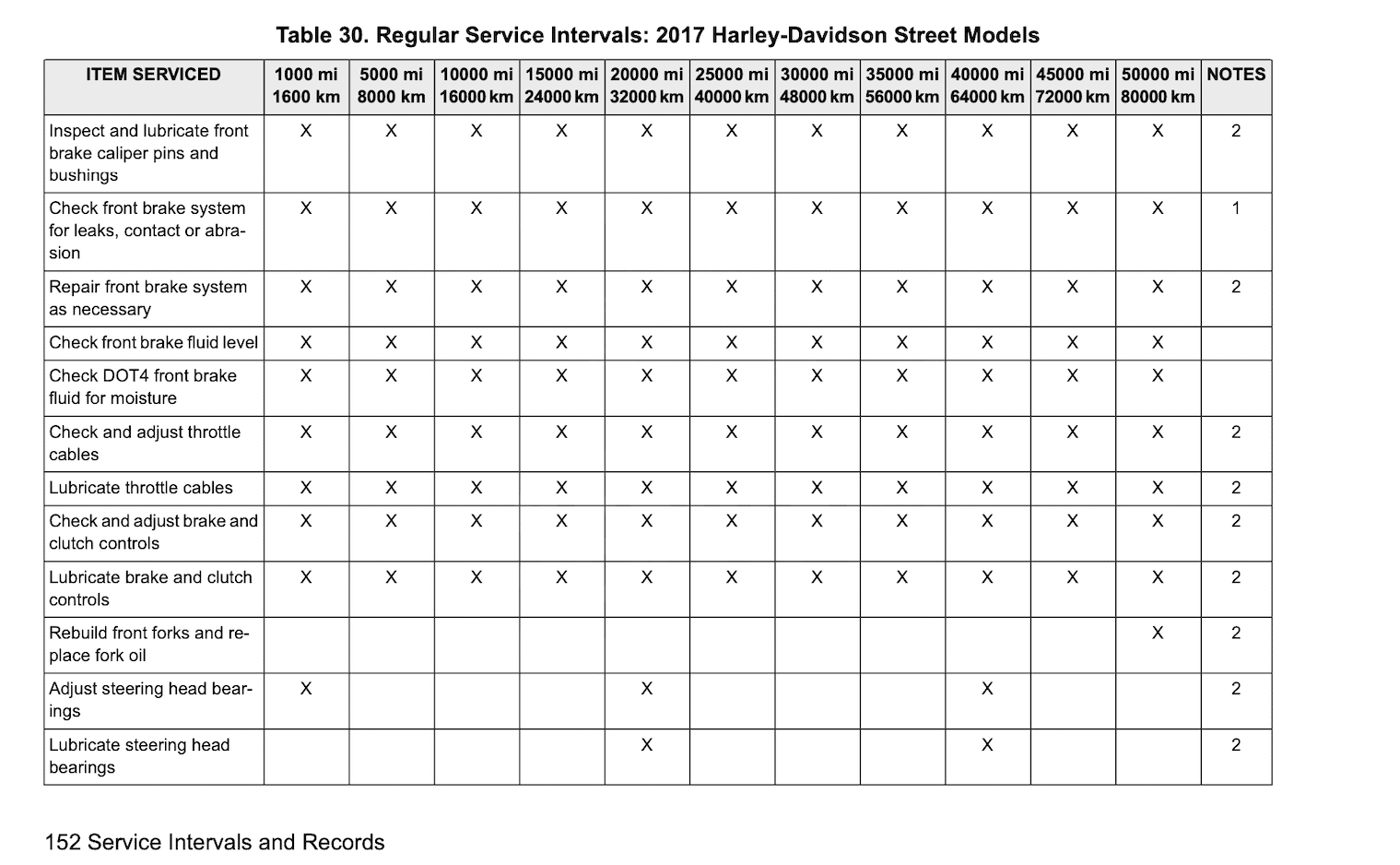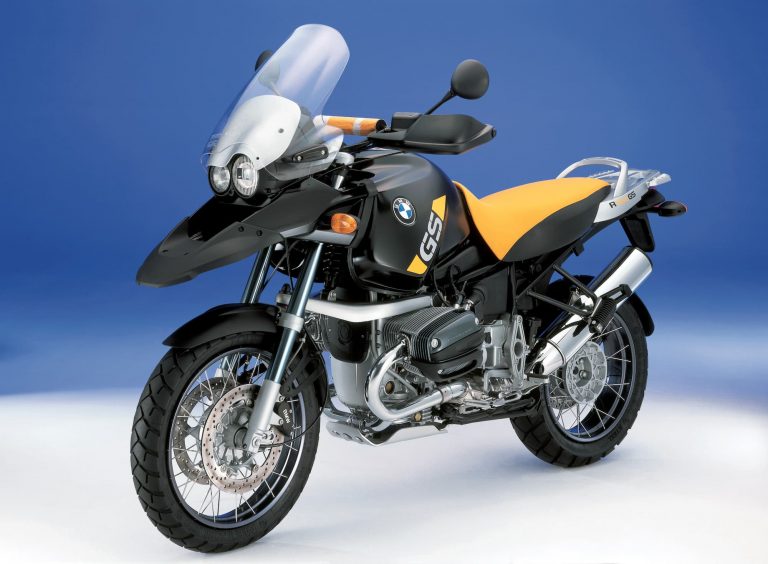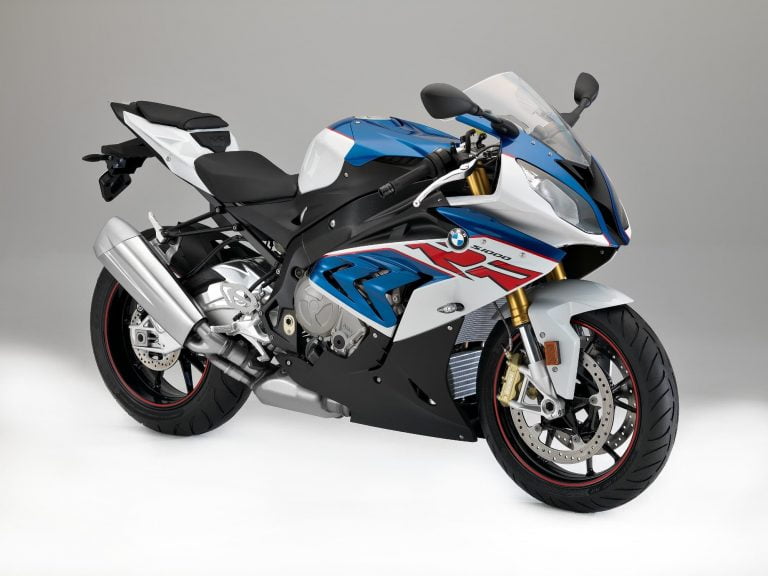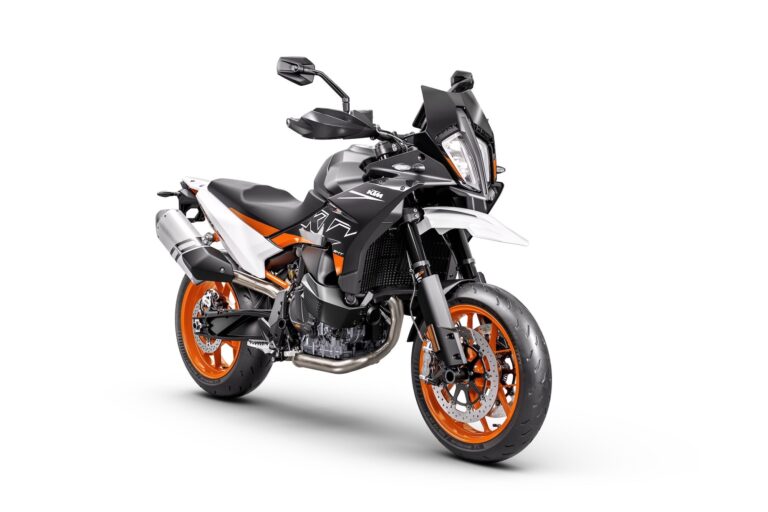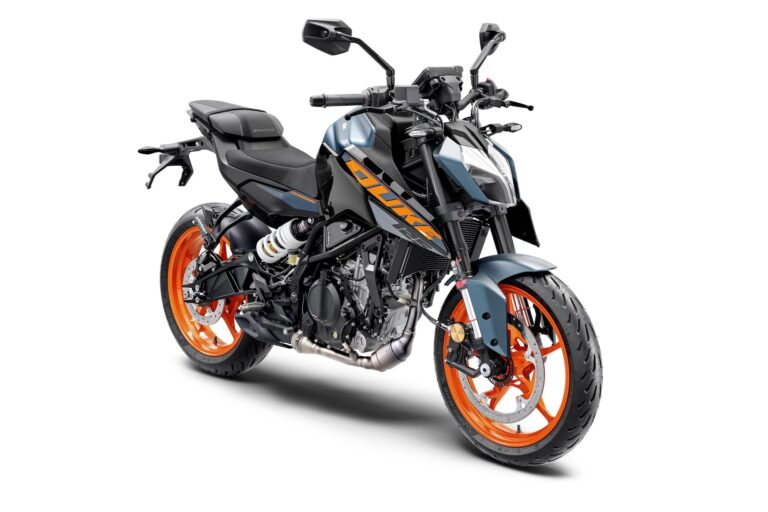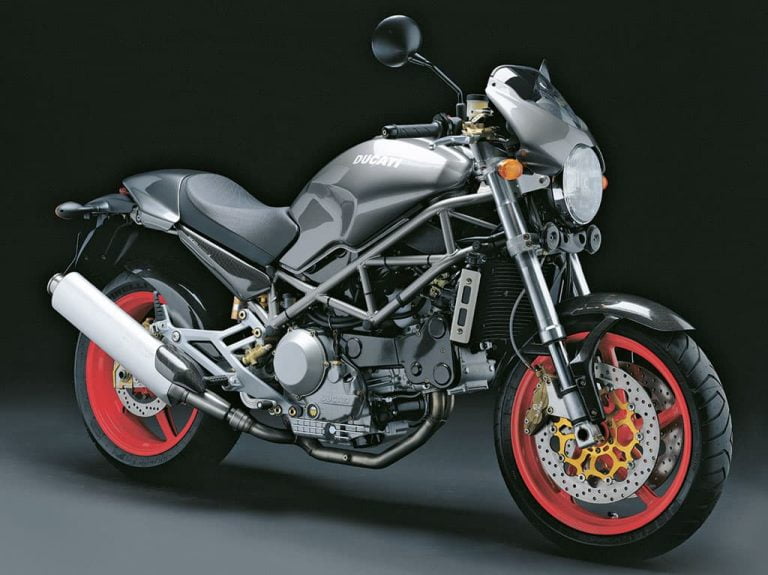Harley-Davidson Street 750 (2015-2020) Maintenance Schedule / Service Info
This is the maintenance schedule plus additional service information for the Harley-Davidson Street 750 (XG750), a member of Harley-Davidson’s mid-sized range offered from 2015-2020 in various markets (not all for all models).
The Street 750 is the bigger sibling of the Street 500. Since it’s not learner-legal in some jurisdictions, it was limited to some markets.
The Harley-Davidson Street 750 is based on the 749 cc liquid-cooled Revolution X V-twin engine. It’s spec’d at 44 lb-ft / 59 Nm at 4000 rpm, optimised for mid-range torque over top-end power. The final drive is via a 6-speed transmission and a belt drive.
Other motorcycles in the Street range include the Street 500 (XG500) and the later-released and higher-spec Street Rod (XG750A).
This site has links for things like oil and spark plugs from which we earn a commission (which unfortunately nobody can save, not even us). If you appreciate this work, then please use those links. Thanks!
Service Intervals for the Street 750 (XG750)
Generally, the Harley-Davidson Street 750 (XG750) has 5,000 mile / 8,000 km or annual service intervals. At each of these periods (whichever comes first), change the oil and filter, and do a host of other checks on the motorcycle.
The major valve lash adjustment service is every 15,000 mi or 24,000 km (with no time component). While the Street 750’s Revolution X engine doesn’t have hydraulic valve lash adjusters (as do most other big Harley engines, including the Sportsters with the Evo engines), the valve check and adjustment procedure is at least simple, as the engines have a single overhead cam design, and the valve adjustment is via a screw-and-locknut type adjustment — i.e. you can do the check and the adjustment with the camshafts in place. The only complication is that there are two cylinder heads.
Aside from that, maintain your Street 750’s fluids regularly, replacing your brake fluid and your coolant per the schedule. (The Street 750 has infrequent coolant replacements, as it’s based on distance only, and Harley specifies an OAT coolant.)
The Street 750’s final drive is a belt, so that aspect of maintenance is easy. Just check it for wear and tension and adjust as needed.
Maintenance schedule for the Harley-Davidson Street 750
Below is the service schedule for the Harley-Davidson Street 750 (XG750). This comes from the manual but has been clarified for usability.
For simplicity, the schedule is broken into two sections:
- The maintenance schedule of main items like oil changes, spark plugs, and valve service, and
- The “Annual inspection” checklist of items to go over
Major items maintenance schedule
Below is the schedule of major items to be serviced on the Harley-Davidson Street 750.
Notes
- The break-in period has passed, so that part of the schedule is omitted.
- If an item (e.g. oil changes) has to be serviced at a certain distance or time, follow the earlier of the two.
- At the end of the schedule, keep repeating it in the pattern shown.
| mi x 1000 | 5 | 10 | 15 | 20 | 25 | 30 | |
|---|---|---|---|---|---|---|---|
| km x 1000 | 8 | 16 | 24 | 32 | 40 | 48 | Every |
| Annual service checklist (see below) — Perform all items | ✓ | ✓ | ✓ | ✓ | ✓ | ✓ | Year |
| Engine oil — Replace (Harley recommends their own brand H-D 360, or a 20W-50 engine oil with CH-4 or above classification, e.g. Mobil 1 20W-50) | ✓ | ✓ | ✓ | ✓ | ✓ | ✓ | Year |
| Oil filter — Replace (HF175) | ✓ | ✓ | ✓ | ✓ | ✓ | ✓ | Year |
| Air filter, — Inspect, and clean/replace if required (HD-4915, different from other Street models) | ✓ | ✓ | ✓ | ✓ | ✓ | ✓ | More often if riding in severe conditions |
| Valve clearances (valve lash) — Inspect, adjust as necessary | ✓ | ✓ | More frequently in severe conditions | ||||
| Spark plugs — Replace (NGK CR9E or CR9EIX for iridium plugs) | ✓ | 2 years | |||||
| Brake fluid (front and rear) — Replace (Castrol DOT 4) | 2 years | ||||||
| Coolant — Replace (Harley-Davidson Extended Life Coolant, or an equivalent OAT coolant, e.g. Zerex G30) | ✓ | 30,000 mi (48,000 km) | |||||
| Shift and brake pedals — Clean and lubricate (lithium soap-based grease), and inspect for wear | ✓ | ||||||
| Steering head bearings — Lubricate | ✓ | ||||||
| Rear fork bearing — Inspect | ✓ | ||||||
| Rear shock absorber bushings — Inspect for wear and cracks | ✓ | ||||||
| Front fork — Rebuild (disassemble, inspect, rebuild, replace fork oil) | 50,000 mi (80,000 km |
Annual Service Checklist
Below is the annual service checklist for the Street 750 (XG750). Do these checks at every service, annual or at distance intervals.
Note — Items marked “Annual” in the right column need to be done annually as well as at distance intervals. The others don’t need to be done at an annual service if no mileage has been done.
| Harley-Davidson Street 750 (XG750) Inspection checklist | Annual |
|---|---|
| Brake systems — Inspect for leaks, contact, or abrasion. Repair as necessary | ✓ |
| Brake fluid, front and rear — Check moisture content. Replace if over 3%. (use Castrol DOT 4) | ✓ |
| Fuel lines and fittings — Check for leaks, contact, or abrasion. Repair as necessary | ✓ |
| Front and rear tires — Check pressure and tread. Adjust or replace if necessary (see below for tire pressure recommendations) | ✓ |
| 12 volt battery — Check terminal torque, connection cleanness, lubricate terminals with contact lubricant | ✓ |
| Exhaust system, fasteners, and shields — Check for leaks, cracks, loose or missing fasteners/shields | ✓ |
| Fuel cap lock — Lubricate with generic grease | ✓ |
| Drive belt and sprockets — Inspect condition and tension, adjust as necessary | |
| Brake pads and discs, front and rear — Inspect for wear, replace if necessary (The XG750 has a single front disc and 2-piston sliding caliper) | |
| Brake caliper pins and bushings, front and rear — Inspect and lubricate | |
| Brake fluid, front and rear — Check level, top up as necessary (brake level drops with pad wear) | |
| Brake and clutch controls — Check, adjust, and lubricate (Use Protect all cable life) | |
| Throttle cables — Check, adjust, and lubricate (Protect all cable life) | |
| Cooling system — Check for leaks and clamps for tightness | |
| Coolant — Check level and freeze point. Replace as necessary (Zerex G30) | |
| Radiator — Clean | |
| Jiffy stand — Check and lubricate | |
| Electrical equipment and switches — Check operation | |
| Road test — Verify components and system functions |
Valve Clearances (Street 750)
The Street motorcycles all have mechanical valve lifters, so you need to check and adjust the valve clearances periodically.
To adjust the valve clearances on your Harley-Davidson Street 750, follow the below procedure.
- Remove the ground cable from the frame stud for safety.
- Loosen and move the fuel tank backwards to increase working room, installing a wood brace to hold it.
- Pull the spark plug leads (but don’t remove the plugs yet)
- Remove the valve cover bolts (8mm wrench)
- Remove the air cleaner assembly (check the cleaner at the same time), and the breather assembly.
- Protect the valve cover with a cloth, lift it, and remove it.
- Clean debris away from spark plug and remove plugs.
- Jack up the motorcycle until the rear wheel is free
- Rotate the wheel forward. Find the TDC — arrow on the camshaft sprocket should be pointing up.
- Use feeler gauges to measure the clearances.
Below are the valve clearances for the XG750 from the service manual
| Valves | mm | in |
|---|---|---|
| Intake valves | 0.15-0.20 | 0.006-0.008 |
| Exhaust valves | 0.20-0.25 | 0.008-0.010 |
Note: The clearances are different across the three XG motorcycles.
If the valves are out of spec (or at the loose end of the range), tighten them to the tightest end of the range. Use a 10mm tappet lash adjustment tool along with a clearance gauge. After setting the clearance, tighten the locknut, and re-check the thickness.
When replacing the cover, use a new gasket if necessary. Then re-install all the components in the reverse order.
The video below (starting at 19:07) is an excellent reference and is applicable to the Street 500, Street 750, and Street Rod.
Street 750 Drive Belt Maintenance
While a drive belt is low maintenance, Harley-Davidson still recommends you regularly check the belt for wear or damage as part of the pre-ride checklist. They get old, rocks get caught in them, and they’re still exposed to the elements.
At every service, you also have to check drive belt condition and deflection. Check deflection using a standard belt tension tool.
Follow this procedure for checking belt tension on the Harley-Davidson Street 750.
- Put the motorcycle on its side stand and in neutral.
- Find the belt deflection measurement window on the side of the motorcycle. Use a belt tension tool to push up on the drive belt in this area with a pressure of 10 lb / 4.5 kg.
- Measure the belt deflection. Each gradation is 1/16 in (1.6 mm)
Target belt deflection for the Street 750 (XG750): 12.6-15.9 mm (0.5-0.62 in) (8-10 gradations)
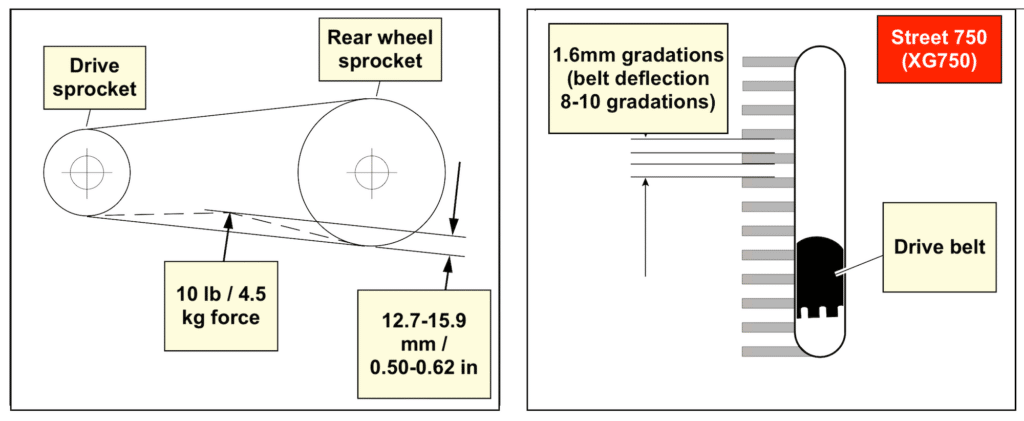
If the belt is out of spec, then you need to adjust it (usually tighten). Follow these steps:
- Elevate the rear wheel using a stand. (You take the tension measurements with the wheel on the ground, but adjust the tension with the wheel elevated, as you need to move the axle back.)
- Use a breaker bar with an appropriate wrench to loosen the rear axle. You may need a special wrench or to remove the exhaust.
- Use a small wrench to turn the belt tension adjusters on either side of the bike. Make small changes — a 1/4 turn can make a huge difference. You have to lower the motorcycle again to measure the deflection with the weight on the wheel again.
- Make sure you tighten the nuts the same amount on each side. Check the belt and make sure it’s in tension and aligned.
- Tighten the rear axle to 96-104 lb-ft or 130-141 Nm with a large torque wrench.
XG750 Tire (Tyre) Sizes and Pressures
The Harley-Davidson Street 750 ships with a 17/15-inch tire combination. The XG750 ships with Michelin Scorcher tires in Western markets and MRF tires in India.
| Wheel | Tire size (USA, Europe, Australia, Rest of world) | Tire size (India) | Tire pressure (USA, Europe, Australia, Rest of world) | Tire pressure (India) |
|---|---|---|---|---|
| Front | Michelin Scorcher 11 100/80-17 M/C 52H | MRF Zapper 100/80-17 M/C 52H | 34 psi / 234 kPa | 30 psi / 207 kPa |
| Rear | Michelin Scorcher 11 140/75R15 M/C 65H | MRF Zapper 140/70-15 M/C 67H | 42 psi / 290 kPa | 40 psi. 276 kPa |
(Note the rear tire size is slightly different on the MRF Zapper tires, too.)
Naturally, adjust tire pressures to suit your conditions and riding style.
About the Harley-Davidson XG750 / Street 750

The Harley-Davidson Street 750 (XG750) is part of the Harley-Davidson’s middleweight “Street” range, which includes the Street 500 and Street Rod (XG750A, not to be confused with the VRSCR).
It has since been discontinued, but for many, it was (and continues to be) an excellent entry point into a few different Harley-Davidson ecosystems, including the general “V-Twin” section as well as the RH Sportster / Nightster segment.
The Street 750 was on the market at the same time as the entry level Sportster 883, with which it often drew comparison. They’re both similarly basic, but the Street 750 has an obviously more modern motor, with liquid cooling and overhead valves both helping it rev higher and make more top-end power.
But at its core, the Street 750 is still a V-twin (albeit 60 degrees). Its 749 cc single overhead cam engine makes healthy peak power of 58 PS / 43 kW @ 8000 rpm (those specs are from the Europe-spec motorcycles, where Harley more often releases power specs). Torque comes on very low, at around half those revs, so this is a bike you’re still likely to short shift.
The rest of the ride components are very simple. There’s just a single disc with a two-piston caliper up front. The forks are non-inverted and non-adjustable. The twin rear shocks are adjustable only for preload.
That’s the charm of bikes like the Harley-Davidson Street 750, though. It’s a modern bike (it has fuel injection and even optional ABS — but at a Harley price! Markets where it’s standard will be breathing a sigh of relief…) that’s very easy to live with. It has plenty of quirks, but it’s also not a machine most people would be afraid to modify with different exhausts, handlebars, footpegs, and other components.
The chassis is a very simple one, a double downtube design that you can support from underneath when it becomes time to work on the suspension or drivetrain. That’s part of what makes it so heavy, and the heaviness is what makes the Street 750 more attractive so much of the market.
The Street 750 didn’t make it to every market. It wasn’t sold in Australia, for example, which only got the Street 500 as well as the later Street Rod.
If you’re wondering what the differences are between the different models, here’s a summary table.
| Model | Street 500 (XG500) | Street 750 (XG750) | Street Rod (XG750A) |
|---|---|---|---|
| Years | 2015-2020 | 2015-2020 | 2017-2020 |
| Displacement | 494 cc | 749 cc | 749 cc |
| Bore / Stroke | 69 x 66 mm | 85 x 66 mm | 85 x 66 mm |
| Compression ratio | 10.5:1 | 11.0:1 | 12.0:1 |
| Fuel requirement | Regular: 87 (PON) / 91 (RON) | Regular: 87 (PON) / 91 (RON) | Premium: 91 (PON) / 95 RON |
| Peak power (from Europe specs) | 36 PS / 27 kW @ 7100 rpm | 58 PS / 43 kW @ 8000 rpm | 70 PS / 52 kW @ 9000 rpm |
| Peak torque | 29.5 lb-ft / 40 Nm @ 3750 rpm | 44 lb-ft / 59 Nm @ 4000 rpm | 47.2 lb-ft / 64 Nm @ 4000 rpm |
| Front brakes | Single 300 mm disc, 2-piston floating caliper | Single 300 mm disc, 2-piston floating caliper | Dual 300mm brakes, 2-piston floating calipers |
| Wheel size combo | 17 / 15 inch | 17 / 15 inch | 17/17 inch |
| Suspension travel (F/R) | 140 / 90 mm 5.5 / 3.5 in | 140 / 90 mm 5.5 / 3.5 in | 132 / 117 mm 5.2 / 4.6 in |
| Lean angle (L/R degrees) | 28.5 / 28.5 | 28.5 / 28.5 | 37.3 / 40.2 |
| Running weight | 233 kg / 514 lb | 233 kg / 514 lb | 238 kg / 525 lb |
The Street 750, as you can see, sits between the Street 500 and the Street Rod.
On the one hand, the 750 has the same basic drivetrain, suspension, and brakes as the 500 — just with more poke to help move that hefty chassis.
On the other hand, there’s an obvious appeal to a bike like the 750, which has more power and more braking ability.
But no motorcycle in this range will set the world on fire. They’re still all very heavy for the power output. These bikes are designed to appeal to someone who wants an entry-level Harley V-Twin but is a little more broad minded than the air-cooled Evo-powered sportster.
Finally, the low-maintenance design of the Street 750 is likely to appeal to many.
The Street 750 is a popular Harley-Davidson in India. It’s built there for non-American markets, it’s more affordable, and its size is more appropriate for many Indian roads where high speeds and heavy machine weights are less practical.
The Harley-Davidson Street 750 is popular among its fans, but Harley-Davidson discontinued it in 2020 as it failed to capture the market share they were after. If you want an entry-level cruiser, look at the revised Nightster.
Reference — Screenshots from the Manual
The above information came from the owner’s manual for the “Street” motorcycles for 2015 and 2017, comparing the schedule for changes (there aren’t any). See a few screenshots below.
You can download manuals for the Harley Davidson motorcycles at the Service Information Portal (but you need an account).
